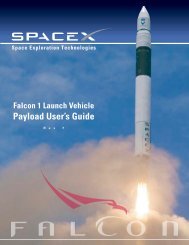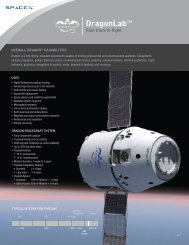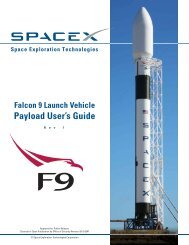US Air Force Evolved Expendable Launch Vehicle (EELV) - SpaceX
US Air Force Evolved Expendable Launch Vehicle (EELV) - SpaceX
US Air Force Evolved Expendable Launch Vehicle (EELV) - SpaceX
Create successful ePaper yourself
Turn your PDF publications into a flip-book with our unique Google optimized e-Paper software.
<strong>US</strong> <strong>Air</strong> <strong>Force</strong> <strong>Evolved</strong> <strong>Expendable</strong> <strong>Launch</strong> <strong>Vehicle</strong> (<strong>EELV</strong>)<br />
<strong>SpaceX</strong> Falcon Offers Lower Costs, High Reliability and Commercial Success<br />
If allowed to compete, <strong>SpaceX</strong> can help DOD save at least one billion dollars annually in space launch, while providing<br />
a truly independent family of vehicles to help assure access to space.<br />
Background<br />
The <strong>Evolved</strong> <strong>Expendable</strong> <strong>Launch</strong> <strong>Vehicle</strong> (<strong>EELV</strong>) is the United States<br />
<strong>Air</strong> <strong>Force</strong> (<strong>US</strong>AF)’s program to launch satellites into orbit. The program<br />
was designed to assure access to space for the Department of Defense<br />
and other United States government payloads and lower costs by at<br />
least 25% and with a goal of 50%. DOD now faces a serious set of<br />
challenges, including:<br />
• Continued Cost Escalation. In one year, the <strong>Air</strong> <strong>Force</strong>’s <strong>EELV</strong><br />
budget request increased by more than 30 percent to $1.74<br />
billion in the FY2012 budget request—at a time when most<br />
programs are seeing cuts. The prime engine supplier, Pratt &<br />
Whitney, recently explained to the press that it will continue to<br />
pass significant cost increases to <strong>US</strong>AF as a result of<br />
cancellation of some NASA programs. If this cost growth<br />
continues, the <strong>EELV</strong> budget would consume the entire DOD<br />
space budget by the end of the decade.<br />
• No Competition. The 2006 merger of Lockheed and Boeing’s<br />
launch businesses resulted in the creation of the United <strong>Launch</strong><br />
Alliance (ULA) and left the <strong>US</strong>AF with a monopoly provider with<br />
no incentive to reduce costs, innovate or increase the quality of<br />
service. DOD currently relies exclusively on the United <strong>Launch</strong><br />
Alliance (ULA).<br />
• $1 Billion “Capability” Subsidy. Because the government is<br />
currently its only customer, DOD and the National<br />
Reconnaissance Office (NRO) are forced to pay well over $1<br />
billion a year to ULA simply to “sustain” the <strong>EELV</strong> capability, which includes subsidizing virtually all of ULA’s fixed costs for<br />
facilities, support costs, and launch operations.<br />
• Inability to Cost Share. Because ULA costs are so high, it charges prices that currently no one but the <strong>US</strong> Government<br />
can afford. ULA has limited ability to leverage the total launch market to reduce its costs.<br />
• No Assured Access. <strong>EELV</strong> initially intended to guarantee assured access to space by having two launch vehicle<br />
providers—Boeing with the Delta and Lockheed with the Atlas. The premise that two providers provides assured access<br />
breaks down with the Atlas and Delta now since both vehicles rely on the same upper-stage engine and share production<br />
facilities. A production failure or disruption at a single location can impact the entire DOD space program.<br />
Why the <strong>EELV</strong> Program Needs Falcon<br />
In the current fiscal environment, DOD can no longer ignore the benefits of competition to national security space launch or the<br />
opportunity for the U.S. government to increase its buying power for the taxpayer through its use. <strong>SpaceX</strong> offers DOD its Falcon 9<br />
and Falcon Heavy rockets along with:<br />
• Reliability. Falcon 9 and Falcon Heavy are designed for maximum reliability (see sidebar).
• Proven Track Record. Falcon 9 has over 30 missions under contract with almost a dozen customers scheduled to launch<br />
several billion dollars in satellites.<br />
• Substantial Cost Savings. The 2012 budget for four <strong>Air</strong> <strong>Force</strong> launches is $1.74B, which is an average of $435M per<br />
launch. Falcon 9 is offered on the commercial market for $50-60M and Falcon<br />
Heavy is offered for $80-$125M. For government missions, NASA has added<br />
mission assurance and additional services to the Falcon 9 for less than $20M.<br />
• Competitive Advantage. <strong>SpaceX</strong> offers affordable pricing as it designed its<br />
vehicles with current and sustainable technology from the ground up. While<br />
ULA relies almost exclusively on the government, <strong>SpaceX</strong> competes on the<br />
commercial and international launch market and wins. As a result, <strong>SpaceX</strong> can<br />
spread its costs over multiple users and reduce its overall cost to the<br />
government, whereas DOD and NRO are stuck paying virtually all of ULA’s<br />
costs.<br />
• Readiness. <strong>SpaceX</strong> can provide launch services to the Pentagon at a fraction<br />
of current costs (see below). The sooner DOD supports new entrants with<br />
contracts for <strong>EELV</strong>-class launches, the sooner the government and the<br />
taxpayer can reap the benefits of competition—save money while maintaining<br />
reliable, innovative, assured access to space.<br />
• Better Access for the <strong>Air</strong> <strong>Force</strong>. <strong>SpaceX</strong> is located just miles from the <strong>Air</strong><br />
<strong>Force</strong> acquisition office, making for easy contract management and mission<br />
assurance teaming. Hardware is built at <strong>SpaceX</strong>, not thousands of miles from<br />
the program office, with fewer subcontractors, allowing for better understanding<br />
and quicker responsiveness for the <strong>Air</strong> <strong>Force</strong>.<br />
• All-American. The <strong>SpaceX</strong> Falcon 9, Falcon Heavy and Merlin engines are<br />
100% American made. With over 80% of the value of our vehicles<br />
Bottom Line<br />
Falcon: Designed for<br />
Maximum Reliability<br />
Multiple engines with ability<br />
to lose an engine and still<br />
make orbit;<br />
Two stages, minimizing<br />
stage separation events;<br />
Triple redundant flight<br />
computers and avionics;<br />
Structural safety factors in<br />
excess of industry<br />
standards;<br />
Unique hold-on-launch<br />
system to ensure launch<br />
success.<br />
Designed from inception to<br />
carry astronauts, thereby<br />
meeting robust human<br />
spaceflight requirements.<br />
manufactured in house, <strong>SpaceX</strong> is able to better control quality and schedule while keeping overall costs low, without using<br />
last century's costly technology.<br />
If allowed to compete, <strong>SpaceX</strong> can help DOD save at least one billion dollars annually in space launch, while providing a truly<br />
independent family of vehicles to help assure access to space.<br />
ULA <strong>SpaceX</strong><br />
Capability Sustainment (independent of # of $1Billion (+ TBD $0<br />
launches)<br />
classified portion)<br />
Cost per launch (medium class) $180M $75M<br />
Cost per launch (heavy class) $350M $125M*<br />
Total <strong>Launch</strong> Costs* $1.7B* $1B*<br />
Total Cost of Current Program $2.7 Billion + TBD<br />
classified portion<br />
Estimated savings with Falcon (assuming 8 <strong>EELV</strong> launches per year): ~$1.7B - $2.2B per year<br />
*Cost for 6 Medium and 2 Heavy ULA launches.<br />
*Cost for 8 Falcon Heavy launches. Reflects commercial pricing for Falcon Heavy.<br />
$1B





